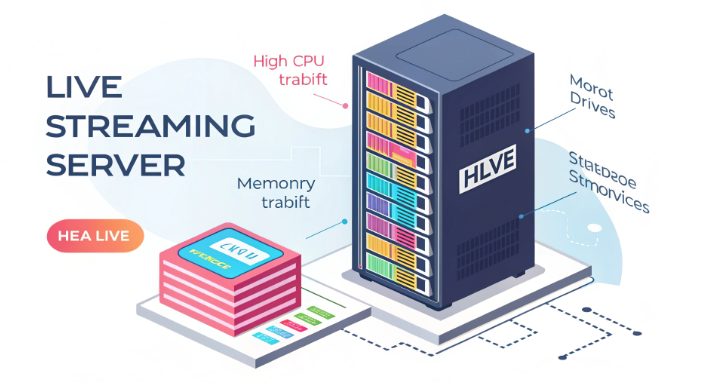Stable and Secure Live Streaming Server Configurations

The landscape of live streaming technology has evolved dramatically, with global streaming traffic projected to reach 82% of all internet traffic by 2025. This explosive growth demands robust server infrastructure that can handle real-time content delivery while maintaining optimal performance and security. As a tech professional seeking the ideal live streaming server configuration, understanding the intricate balance between hardware specifications, network requirements, and security measures is crucial for building a reliable streaming platform.
Critical Hardware Specifications
When architecting a streaming server environment, CPU selection forms the cornerstone of your infrastructure. Enterprise-grade Intel Xeon processors (particularly the Scalable series) or AMD EPYC processors deliver the necessary computing power with advanced features like AVX-512 instructions for efficient video processing. For professional streaming operations, consider these CPU configurations:
– Entry-level: 8 cores/16 threads (suitable for 720p streaming up to 500 concurrent viewers)
– Mid-tier: 16 cores/32 threads (optimal for 1080p streaming with 1000-2000 viewers)
– Enterprise: 32+ cores/64+ threads (necessary for 4K streaming or 5000+ concurrent connections)
Clock speeds should maintain a minimum of 2.5GHz base frequency, with boost capabilities reaching 3.5GHz+ for handling encoding spikes.
Memory and Storage Architecture
RAM configuration plays a pivotal role in streaming performance, acting as a crucial buffer for real-time data processing. Implementation guidelines include:
– Basic streaming (up to 720p): 32GB DDR4 ECC RAM
– Professional streaming (1080p): 64GB DDR4 ECC RAM
– Enterprise solutions (4K): 128GB+ DDR4 ECC RAM
Memory channels should be properly balanced for optimal performance, utilizing dual or quad-channel configurations.
Storage architecture demands careful consideration:
– Primary drive: NVMe SSDs (minimum 1TB) for OS and streaming software
– Content storage: RAID 10 configuration with enterprise SSDs
– Backup storage: High-capacity HDDs in RAID 6 for archived content
Network Infrastructure Requirements
Bandwidth allocation represents the critical factor in streaming server deployment. Calculate required bandwidth using the comprehensive formula:
Total Bandwidth = (Bitrate × Concurrent Viewers × 1.2) + [(Peak Viewer Count × Average Bitrate) × Redundancy Factor]
For various streaming qualities:
– 720p (3Mbps): ~3.6Gbps for 1000 viewers
– 1080p (6Mbps): ~7.2Gbps for 1000 viewers
– 4K (25Mbps): ~30Gbps for 1000 viewers
Advanced Security Implementation
Modern streaming platforms require a sophisticated, multi-layered security approach. Implementation requires:
DDoS Protection Architecture:
– Layer 3/4 protection: Hardware-based mitigation up to 100Gbps
– Layer 7 protection: Application-level filtering with behavior analysis
– TCP/UDP flood protection with adaptive thresholds
– Geographic-based traffic filtering
SSL/TLS Implementation:
– Automated certificate management through Let’s Encrypt
– Perfect Forward Secrecy (PFS) enabled
– TLS 1.3 with optimal cipher suites
– HSTS implementation with preloading
US Server Infrastructure Advantages
US-based facilities provide enterprise-grade infrastructure with key benefits:
Network Infrastructure:
– Direct peering with major CDNs (Akamai, Cloudflare, Fastly)
– Average East-West Coast latency < 40ms
– Multiple Tier-1 provider connections
– IPv6 support with dual-stack implementation
Physical Infrastructure:
– 2N+1 redundant power systems
– Advanced cooling solutions with N+1 redundancy
– 24/7 NOC monitoring
– SSAE 16 Type II certified facilities
Performance Optimization Techniques
Kernel-level optimizations enhance streaming performance:
# Network stack tuning net.core.rmem_max = 16777216 net.core.wmem_max = 16777216 net.ipv4.tcp_rmem = 4096 87380 16777216 net.ipv4.tcp_wmem = 4096 65536 16777216 net.ipv4.tcp_max_syn_backlog = 4096 net.core.netdev_max_backlog = 50000
Monitoring and Analytics
Implement comprehensive monitoring solutions:
– Real-time viewer analytics
– Bandwidth utilization tracking
– Server resource monitoring
– Error rate and latency metrics
Integration with popular monitoring stacks:
– Prometheus for metrics collection
– Grafana for visualization
– ELK stack for log analysis
– Custom alerting thresholds
Conclusion
Selecting the optimal live streaming server configuration requires careful consideration of hardware specifications, network infrastructure, and security measures. US-based hosting solutions offer robust infrastructure, comprehensive security features, and excellent connectivity options for professional streaming operations. Regular performance monitoring and proactive optimization ensure sustained streaming quality for your growing audience.

